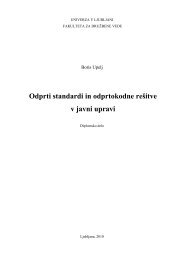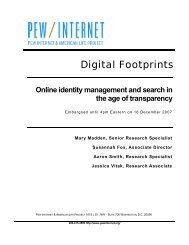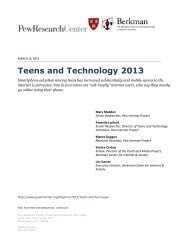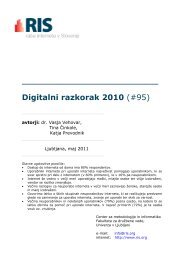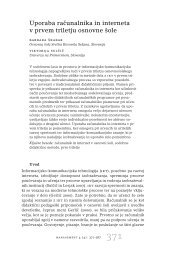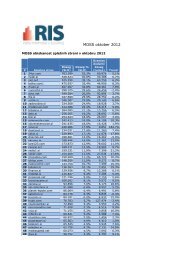the Labour Market Survey Report - Council of European ...
the Labour Market Survey Report - Council of European ...
the Labour Market Survey Report - Council of European ...
Create successful ePaper yourself
Turn your PDF publications into a flip-book with our unique Google optimized e-Paper software.
Executive Summary<br />
The current state <strong>of</strong> <strong>the</strong> IT Practitioner * workforce within <strong>the</strong> <strong>European</strong> Union is assessed, with <strong>the</strong><br />
position in four Member States being studied in some detail, in particular through review <strong>of</strong> <strong>the</strong> most<br />
recent national analyses and examination <strong>of</strong> levels <strong>of</strong> employment <strong>of</strong> <strong>the</strong> core technical communities<br />
from <strong>of</strong>ficial statistics over a five year period.<br />
The report examines:<br />
• <strong>the</strong> scale <strong>of</strong> <strong>the</strong> IT Practitioner (“ITP”) labour market;<br />
• <strong>the</strong> economic and policy contexts;<br />
• <strong>the</strong> nature and structure <strong>of</strong> this labour market, and its quantitative position and recent trends in<br />
more detail in Germany, Ireland, Sweden and <strong>the</strong> United Kingdom;<br />
• initial comparisons between Member States <strong>of</strong> certain aspects <strong>of</strong> this labour force, and <strong>the</strong> role<br />
<strong>of</strong> migration;<br />
• <strong>the</strong> challenges <strong>of</strong> estimating skill shortages, in particular into <strong>the</strong> future; and<br />
• four employment growth scenarios, to provide insights into future supply challenges.<br />
The two o<strong>the</strong>r significant analyses <strong>of</strong> <strong>the</strong> <strong>European</strong> level position are reviewed in some depth, and<br />
an analysis and forecasting approach was adopted for <strong>the</strong> study that overcomes certain <strong>of</strong> <strong>the</strong>ir<br />
limitations.<br />
Levels <strong>of</strong> employment in <strong>the</strong> four countries selected are presented from Eurostat holdings <strong>of</strong> national<br />
<strong>Labour</strong> Force <strong>Survey</strong> <strong>of</strong>ficial statistics in two occupational areas (“Computing Pr<strong>of</strong>essionals” and<br />
“Computer Associate Pr<strong>of</strong>essionals”) over a five year period. While <strong>the</strong>se figures are generally<br />
noticeably below <strong>the</strong> “headline” figures assumed within recent national employer surveys (which have<br />
<strong>of</strong>ten covered - all occupations in - <strong>the</strong> supply sector), <strong>the</strong>y are more meaningful in representing <strong>the</strong><br />
scale <strong>of</strong> <strong>the</strong> core technical communities requiring <strong>the</strong> hard technical skill needs on which public policy<br />
development in relation to IT Practitioner skills must primarily focus.<br />
Levels and recent trends <strong>of</strong> a number <strong>of</strong> aspects <strong>of</strong> this workforce are reported, and <strong>the</strong> <strong>of</strong>ficial figures<br />
suggest noticeable differences between <strong>the</strong> four Member States examined, in relation to, for example:<br />
• <strong>the</strong> level <strong>of</strong> female employment in this work;<br />
• <strong>the</strong> age pr<strong>of</strong>ile <strong>of</strong> <strong>the</strong> ITP workforce;<br />
• <strong>the</strong> amount <strong>of</strong> self-employment within <strong>the</strong> workforce, and<br />
• <strong>the</strong> share <strong>of</strong> employment within <strong>the</strong> supply (IS Industry) sector.<br />
While this data suffers from certain differences <strong>of</strong> classification – in particular concerning <strong>the</strong> IT Practitioner<br />
occupations – between countries, and <strong>the</strong> findings need fur<strong>the</strong>r verification, <strong>the</strong> trends and certain<br />
ratios remain meaningful, and significant national differences suggest <strong>the</strong> need for fur<strong>the</strong>r exploration.<br />
* In this study, IT Practitioners include both IT (“Informatics”) Pr<strong>of</strong>essionals and non-pr<strong>of</strong>essional dedicated IT<br />
workers. They do not include ei<strong>the</strong>r electronic engineers or Telecommunications workers (<strong>the</strong> study is not <strong>of</strong> ICT<br />
Practitioners) or IT End-Users who make use <strong>of</strong> IT in <strong>the</strong>ir own work.



